

From Chanel to Westwood, 5 times fashion week was about making a political statement. Every fashion week, designers and brands from around the globe, from Kanye West to H&M, strive to put on a headline-generating show.
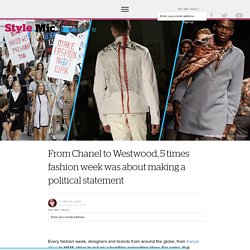
For some, that means having a model spin through the air, or projecting images right onto the models themselves. Designers have literally set stages on fire in hopes of getting people's attention. While some designers have used their platforms to shock or excite their audiences, other designers have used their platforms to start a conversation about the day's politics. Over the past few years in particular, designers have started to make fashion statements at their shows that meld with political statements, whether that means writing on a T-shirt or even unfurling a banner after a show.
Here are just five examples of designers making their shows at fashion week about much more than just clothes. Vivienne Westwood gets real about climate change. Debate: Does Fashion Have A Place In Politics? Why Brexit is good for the fashion industry. On the eve of the EU referendum in June during London Collections Men it wasn’t hard to gauge which direction the fashion pack was leaning.
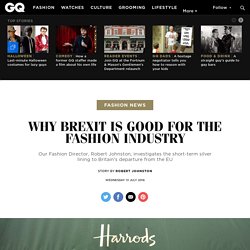
Unsurprisingly, thanks to factors such as the EU support of many of the initiatives of the British Fashion Council (BFF) and the fact that myriad young designers work with factories and suppliers from Lithuania to Lisbon, the community is an outward-looking and inclusive bunch. Indeed, during the campaign the BFC reported that of the near-500 designers it polled, 90 per cent planned to vote for Remain. Now the world has changed and in the face of a probable Brexit, whatever individual’s feelings may be the UK fashion industry has to start accentuating the positive. An obvious short-term silver lining is the weakness of sterling on the international markets has made London a bargain bonanza for shoppers paying in dollars, euros and yuans while reports are that e-tailing is booming. Astonishingly, the effects were almost instantaneous. Fashion Show Review, Ready-to-Wear - Autumn 2016.
MILAN, Italy — For all that it was a triumphant return to form, Miuccia Prada's menswear show in January turned out to be a mere appetiser for the deeper, richer women's collection she showed tonight.
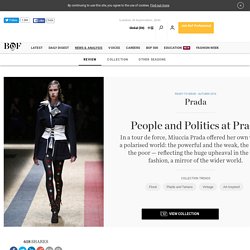
That was partly a reflection of her own feelings: "A woman is so much more complex than a man. She has to be a mother, a lover, a worker, a beauty... " But it was the way the clothes mirrored those multi-facets — and the emotional states that accompany them — that made the show a tour de force. Longtime collaborator Frederic Sanchez’s soundtrack of female singers ran a full drenching gamut, from the fierceness of PJ Harvey, to the pain of Piaf to the chill anomie of Nico, by way of sterling accompaniment. Tears flowed backstage. Her men were mariners, drifters. Some had tiny, padlocked books slung round their necks like pendants.
Why? Does Fashion Have a Place in Politics? Whilst some may argue that fashion and politics have no business being mentioned in the same sentence- I disagree.
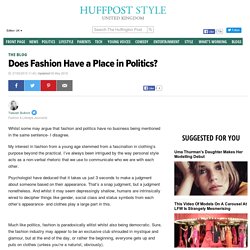
My interest in fashion from a young age stemmed from a fascination in clothing’s purpose beyond the practical. I’ve always been intrigued by the way personal style acts as a non-verbal rhetoric that we use to communicate who we are with each other. Psychologist have deduced that it takes us just 3 seconds to make a judgment about someone based on their appearance.
That’s a snap judgment, but a judgment nonetheless. And whilst it may seem depressingly shallow, humans are intrinsically wired to decipher things like gender, social class and status symbols from each other’s appearance- and clothes play a large part in this. Much like politics, fashion is paradoxically elitist whilst also being democratic. But whilst our personal style decisions can be quite subtle and even subconscious, politician’s sartorial choices are often much more considered than it appears. Fashion’s most iconic political statements. As the date of the UK election draws nearer, politicians have turned their attention to fashion and pop culture in an attempt to wrest the youth vote.
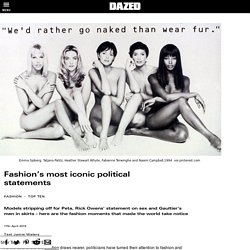
David Cameron has claimed Kardashian kinship, Nick Clegg has starred in an “Uptown Funk” election anthem, and the Labour Party has channelled Katharine Hamnett with their “Hell Yes” slogan tee. These recent antics come as no surprise – fashion and politics have long been linked. Last week we paid tribute to Dame Vivienne Westwood’s best protests, one of the great masters of using fashion as a vehicle for social commentary. Now we turn our attention to other designers who have used their clothes to shine a spotlight on important issues.
From men’s skirts, anti-terrorist slogans and Pussy Riot films, to penises on the catwalk, feminist runway protests and reflections on wartime hardships, here are the most memorable political statements in fashion history. Political Movements in Fashion. Can fashion have a political conscience?
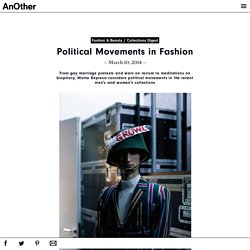
The question is a recurring one, and the answers are all too often clichéd. Examples of the industry’s insensitivity and lack of sympathy (or knowledge) towards social and political realities surface regularly in the media, and stories about blackface editorials and articles praising the “beauty” and “philanthropy” of the wives of Middle East dictators make the movie Zoolander look like a realistic take on the fashion world.
However (and contrary to popular belief) fashion is just as often used as a social commentary.